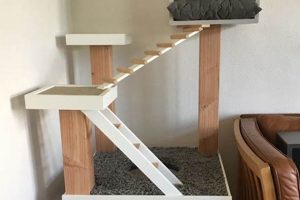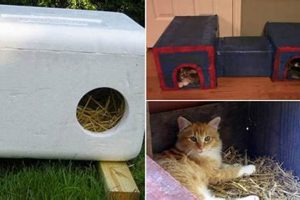A do-it-yourself shelter for unowned, unsocialized felines provides protection from the elements. These structures, often constructed from readily available and inexpensive materials, offer refuge from cold, heat, rain, and snow. As an example, a modified plastic storage container insulated with straw can serve as a viable shelter.
Providing accessible outdoor shelters enhances the welfare of free-roaming cat populations. It mitigates the risks associated with exposure to harsh weather conditions, reducing the likelihood of hypothermia, frostbite, and heatstroke. Historically, community members and animal welfare organizations have implemented such solutions to improve the lives of these animals within their respective environments. The construction and provision of this type of shelter supports community cat management initiatives focused on humane population control and care.
Considerations for constructing effective shelters include material selection, insulation techniques, size and entrance design, and placement within the environment. Addressing these factors maximizes the utility and appeal of the structure to its intended users, promoting its acceptance and utilization by the target feline population. Further discussion will elaborate on specific design considerations.
Shelter Construction and Placement Guidance
The following guidelines facilitate the creation of effective and safe shelters for unowned feline populations. Careful consideration of these points ensures the constructed shelter is well-suited for its intended purpose.
Tip 1: Material Selection: Opt for durable, weather-resistant materials such as plastic storage bins, wood, or repurposed items. Avoid materials that readily absorb moisture, such as cardboard, unless properly sealed and protected from the elements.
Tip 2: Insulation Implementation: Utilize straw, not hay, as an insulating material. Straw provides effective insulation while resisting moisture retention, which is crucial for maintaining a dry and warm environment within the shelter. Blankets and towels should be avoided as they retain moisture and can freeze.
Tip 3: Entrance Design: Construct a small entrance (approximately 6-8 inches in diameter) to minimize heat loss and prevent larger animals from entering the shelter. Consider an offset entrance or a dual-chamber design for enhanced protection from wind and cold.
Tip 4: Shelter Size: The interior of the shelter should be appropriately sized for one to three cats. Overly large spaces allow for heat loss, reducing the effectiveness of the insulation.
Tip 5: Location Selection: Place the shelter in a sheltered location, away from direct wind, rain, and heavy foot traffic. Positioning the structure against a building or under an overhang provides additional protection.
Tip 6: Camouflage and Concealment: Consider camouflaging the shelter with natural materials or placing it in a concealed location to deter human interference and protect the cats from potential threats.
Tip 7: Maintenance and Monitoring: Regularly inspect the shelter for damage and ensure the interior remains dry and clean. Replenish the straw as needed to maintain optimal insulation.
Implementing these construction and placement techniques contributes to the creation of safe and effective shelters, significantly improving the welfare of community cats by providing essential protection from the elements.
The subsequent section explores additional resources and considerations for ongoing care and support of feral feline populations.
1. Insulation
Insulation is a critical component of a do-it-yourself shelter for unowned, unsocialized felines. Its primary role is to mitigate temperature fluctuations within the shelter, providing a stable and protective environment against external weather conditions.
- Material Selection for Thermal Resistance
The choice of insulation material directly impacts the shelter’s ability to maintain a consistent internal temperature. Straw, due to its low moisture retention and effective thermal resistance, is a preferred choice. Alternatives, such as rigid foam insulation, provide a barrier against heat loss or gain. The selected material should prioritize non-toxicity and resistance to decomposition.
- Layering and Thickness Considerations
The effectiveness of insulation is directly proportional to its thickness and layering. Multiple layers of straw, for example, create air pockets that enhance thermal resistance. Adequate insulation thickness is crucial for maintaining a comfortable internal temperature during extreme weather events. Over-packing, however, can reduce airflow and diminish the material’s insulative properties.
- Moisture Management and Insulation Integrity
Maintaining the dryness of insulation is paramount to its performance. Wet insulation loses its thermal resistance and can promote mold growth, creating an unhealthy environment for the animals. Proper ventilation and weatherproofing of the shelter are essential for preventing moisture intrusion and preserving the integrity of the insulation.
- Placement and Coverage within the Structure
Complete and consistent coverage of the shelter’s walls, floor, and roof is necessary for effective insulation. Gaps or thin spots in the insulation allow for heat transfer, compromising the shelter’s ability to maintain a stable internal temperature. Special attention should be given to areas around the entrance to minimize heat loss while maintaining accessibility for the cats.
The successful implementation of insulation within a do-it-yourself shelter requires a holistic approach encompassing material selection, layering techniques, moisture management, and thorough coverage. These considerations directly influence the shelter’s ability to provide a safe and comfortable refuge for community cats throughout the year.
2. Durability
Durability is a paramount attribute of any do-it-yourself shelter for unowned, unsocialized felines. The longevity of the structure directly correlates with its continued protective capability, minimizing the need for frequent repairs or replacements. Material selection, construction techniques, and environmental factors significantly influence a shelter’s overall resilience.
- Material Resistance to Degradation
The choice of materials dictates the shelter’s resistance to weathering, pest infestation, and physical damage. Plastic storage containers, properly sealed wood, or repurposed industrial materials demonstrate inherent resilience to environmental stressors. Conversely, untreated cardboard or thin plastics degrade rapidly when exposed to moisture, sunlight, or animal activity. For example, a shelter constructed from rot-resistant cedar will withstand the elements far longer than one built from untreated pine.
- Structural Integrity and Joint Strength
Robust construction techniques are essential for maintaining structural integrity. Securely fastened joints, reinforced corners, and adequate support mechanisms prevent collapse or deformation under stress. A shelter with weakly constructed joints is susceptible to damage from wind, snow load, or animals climbing on the structure. Consider a shelter framed with sturdy lumber and joined with weatherproof screws for enhanced stability.
- Resistance to Environmental Factors
Exposure to the elements necessitates design considerations that mitigate the effects of moisture, temperature fluctuations, and UV radiation. Weatherproofing techniques, such as sealing seams and applying protective coatings, prevent water intrusion and material degradation. A shelter with a sloped roof will effectively shed rain and snow, reducing the risk of water damage and structural compromise.
- Protection Against Animal Interference
The shelter’s design should deter or withstand interference from other animals, including potential predators or scavengers. Reinforced entrances, heavy-duty latches, and elevated platforms can prevent access or damage. For example, a metal screen over the entrance can prevent larger animals from entering while still allowing cats access.
The long-term utility of a do-it-yourself shelter hinges on its durability. Careful consideration of material selection, construction methods, and environmental factors ensures the structure provides sustained protection for its feline occupants, minimizing the need for ongoing maintenance or costly replacements. This approach reflects responsible resource management and promotes the welfare of community cat populations.
3. Weatherproofing
Weatherproofing represents a critical element in the construction of a durable and effective shelter for unowned, unsocialized felines. Inherent in the “diy feral cat house” concept is the intention to provide refuge from environmental stressors; therefore, design and construction must prioritize protection from rain, snow, wind, and temperature extremes. Inadequate weatherproofing negates the benefits of the structure, rendering it vulnerable to degradation and potentially harmful to its occupants. For instance, a shelter lacking proper roof sealing will allow water ingress, leading to dampness, mold growth, and a reduction in insulation effectiveness. This, in turn, exposes the cats to cold and potentially life-threatening conditions.
Effective weatherproofing strategies include selecting water-resistant materials such as plastic or treated wood. Joints and seams should be sealed with waterproof caulk or sealant to prevent water penetration. Elevated floors minimize contact with ground moisture, reducing the risk of dampness. Overhanging eaves provide further protection from rain and snow. The orientation of the entrance can also be strategically aligned to minimize exposure to prevailing winds. A real-world example involves a community cat shelter built with repurposed plastic barrels, sealed with marine-grade sealant, and strategically placed under an overhanging porch, thus effectively mitigating environmental impact and ensuring a dry and safe haven.
In summary, thorough weatherproofing is not merely an added feature but an essential requirement for any shelter intended for community cats. Neglecting this aspect compromises the structure’s integrity and jeopardizes the well-being of the animals it is designed to protect. The practical significance of understanding and implementing effective weatherproofing techniques lies in ensuring the long-term functionality and humane purpose of these vital shelters.
4. Location
Location fundamentally impacts the effectiveness of a do-it-yourself shelter for unowned, unsocialized felines. The chosen placement dictates the degree of protection offered from environmental elements and potential threats. A poorly situated structure, regardless of construction quality, fails to provide adequate refuge. For instance, a shelter placed in a high-traffic area may deter cats from utilizing it, while one located in a flood-prone zone poses a direct hazard. Therefore, site selection is a critical determinant of the shelter’s utility and the well-being of its inhabitants.
Ideal locations offer a combination of concealment, protection from the elements, and accessibility for the cats. Sites shielded from prevailing winds, direct sunlight, and heavy precipitation are preferable. Proximity to reliable food and water sources, while avoiding areas frequented by predators, enhances the appeal of the shelter. Examples include placing the structure under an overhang, against a building, or within dense vegetation. Community cat caregivers often select locations based on observed feline behavior and established feeding routes, maximizing the likelihood of shelter utilization. Careful consideration of these factors translates directly into increased usage and a more secure environment for the cats.
In conclusion, location is not merely a logistical consideration but an integral component of successful shelter implementation. Its importance stems from its direct influence on shelter usability, safety, and the overall welfare of the target feline population. Addressing the challenges of site selection through careful observation and strategic placement maximizes the potential benefits of the shelter, contributing to the humane management of community cat populations.
5. Size
Shelter size represents a crucial design consideration for structures intended for unowned, unsocialized felines. Dimensions directly influence thermal regulation, occupancy capacity, and perceived safety. An inappropriately sized shelter may deter usage or compromise the well-being of its inhabitants. Therefore, careful deliberation regarding dimensions is essential for maximizing the effectiveness of a shelter.
- Internal Volume and Thermal Efficiency
Internal volume significantly impacts the shelter’s ability to retain heat. Overly large spaces dissipate warmth, reducing insulation effectiveness. Conversely, confined spaces may restrict movement and cause discomfort. An appropriately sized shelter allows cats to conserve body heat efficiently, maintaining a stable internal temperature. Practical examples demonstrate that shelters with internal volumes accommodating one to three cats offer optimal thermal performance.
- Occupancy Capacity and Social Dynamics
Dimensions must accommodate the anticipated number of occupants while considering feline social dynamics. Insufficient space can lead to competition and stress, discouraging shelter usage. Conversely, excessively large spaces may be perceived as insecure. Shelters designed for multiple cats should provide adequate personal space to minimize conflict. Observations of community cat behavior inform appropriate capacity planning, ensuring a harmonious environment.
- Entrance Dimensions and Accessibility
Entrance size influences accessibility and security. Oversized entrances compromise thermal efficiency and allow entry by larger animals. Undersized entrances may deter use by larger cats or those with mobility limitations. Entrance dimensions should strike a balance between ease of access and protection from the elements and potential threats. A typical entrance diameter of six to eight inches serves as a practical guideline.
- Overall Footprint and Environmental Integration
The shelter’s overall footprint should align with the intended placement environment. Bulky structures may be difficult to conceal or integrate into existing landscapes. Compact designs minimize visual impact and facilitate discreet placement. Environmental considerations, such as available space and camouflage requirements, influence the selection of appropriate dimensions. A low-profile shelter, for example, may be suitable for integration into dense vegetation.
The interplay between these dimensional considerations underscores the importance of thoughtful design in constructing shelters. Shelter dimensions must balance thermal efficiency, occupancy needs, accessibility, and environmental integration to maximize utility and promote the welfare of community cat populations.
6. Entrance
The entrance is a critical component of any do-it-yourself shelter for unowned, unsocialized felines, directly impacting its usability and effectiveness. Entrance design influences thermal regulation, security against predators, and the likelihood of cats utilizing the structure. A poorly designed entrance negates the benefits of the shelter, rendering it less effective or even hazardous. For instance, an overly large opening compromises insulation, exposing the occupants to cold and dampness. Conversely, a too-small entrance may deter cats from entering, particularly larger individuals or those with mobility issues. Therefore, entrance design merits careful consideration within the context of a shelter.
Effective entrance design balances accessibility with security and weather protection. Small openings, typically six to eight inches in diameter, minimize heat loss and prevent entry by larger animals such as raccoons or dogs. A raised entrance or tunnel-like extension provides additional protection from wind and rain. Strategic placement, shielded from prevailing winds, further reduces exposure to the elements. Examples include incorporating a hinged flap or creating a baffle system to block direct airflow. Community cat caregivers frequently modify entrances based on observed feline behavior and environmental conditions, optimizing usability and security.
In summary, entrance design is not merely a superficial detail but a functional imperative for shelters. Its importance lies in its direct influence on thermal regulation, security, and usability. Understanding and implementing effective entrance design principles maximizes the potential benefits of shelters and contributes to the well-being of the target feline population. Addressing the challenges of entrance design through careful planning and practical modifications enhances the overall value and effectiveness of shelters.
Frequently Asked Questions Regarding DIY Feral Cat Shelters
The following questions and answers address common inquiries and concerns regarding the construction, maintenance, and utility of self-made shelters for unowned feline populations.
Question 1: What materials are most suitable for building a feral cat shelter?
Durable, weather-resistant materials are paramount. Plastic storage bins, treated lumber, and repurposed construction materials are viable options. Avoid absorbent materials such as untreated cardboard unless adequately sealed and protected from the elements.
Question 2: How should a feral cat shelter be insulated?
Straw is the preferred insulation material due to its low moisture retention and effective thermal properties. Hay is not recommended, nor are fabrics such as blankets, as these retain moisture and can freeze. Ensure adequate insulation thickness for optimal thermal regulation.
Question 3: What is the appropriate size for a feral cat shelter entrance?
A small entrance, approximately six to eight inches in diameter, minimizes heat loss and prevents larger animals from entering. Consider an offset entrance or tunnel design for enhanced protection from wind and predators.
Question 4: Where is the optimal location for placing a feral cat shelter?
Sheltered locations, away from direct wind, rain, and heavy foot traffic, are ideal. Positioning the structure against a building or under an overhang provides additional protection. Observe feline behavior to identify established routes and preferred areas.
Question 5: How often should a feral cat shelter be cleaned and maintained?
Regular inspection is crucial. The shelter should be checked for damage and moisture. Straw should be replaced as needed to maintain insulation effectiveness. Frequency depends on environmental conditions and shelter usage.
Question 6: Are there any safety precautions to consider when building a feral cat shelter?
Use non-toxic materials and avoid sharp edges or protruding fasteners. Ensure adequate ventilation to prevent moisture buildup. Consider camouflaging the shelter to deter human interference.
Effective shelter implementation requires adherence to these guidelines and continuous monitoring of the structure’s condition and usage.
The subsequent section explores considerations for year-round feral cat care.
DIY Feral Cat House
The preceding discussion has explored the essential elements of the shelter. Material selection, insulation techniques, size considerations, and strategic placement are critical components of effective design. A thoughtfully constructed shelter provides essential protection from the elements, enhancing the well-being of unowned feline populations. Adherence to established construction and maintenance guidelines maximizes the utility and longevity of the structure.
The construction and strategic deployment of a diy feral cat house contribute significantly to humane community cat management. Continued dedication to these efforts remains vital, ensuring that vulnerable feline populations receive essential protection. Community involvement in support of this initiative fosters compassion and reinforces responsible animal stewardship.







